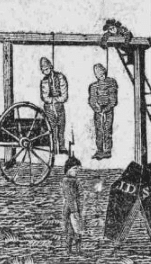
PREV ARTICLE
NEXT ARTICLE
FULL ISSUE
PREV FULL ISSUE
TO COUNTERFEIT 'TIS DEATHPaul Schultz writes: "Just an FYI on a historical footnote, not relevant to the issues of today, you mentioned "Even when the words "To counterfeit 'tis death" were printed on bills I don't think that sentence was ever carried out.-Editor" In England in the 1600s and 1700s it was actually carried out. I do not have the references on hand, but I have read numerous descriptions of counterfeiters being hanged. Of course, they were caught with all of the equipment necessary and stacks of counterfeit money so there was no doubt of guilt. Many people did not approve, others regarded all hangings as an afternoon of amusement, but the practice was discredited before 1800 if I remember right. I can not say if anyone in the American colonies or the US was ever executed for counterfeiting, others may know better than I do. Laws here were a bit lenient compared to Europe, they burned witches at the stake over there, but in the colonial US we just hung them. One was my 10 Greats grandmother, Lydia Gilbert, hung as a witch in 1652 in Hartford CT." I was speaking of the colonial American penalty, and it would only take one example to prove me wrong. But yes, the death penalty for counterfeiting was enforced in other times and places. Sorry to hear about your ancestor! Here's one account of colonial counterfeiting justice. So much has been written on the topic I'm not sure where to start. But I'd be happy to be proven wrong if someone can cite an example of the death penalty for counterfeiting being carried out of U.S. soil. -Editor Ichabod Miller eked out a living on his farm in West Stockbridge, Mass. On December 20, 1772, his pastoral life was turned upside down. Miller was awoken to the commotion of an angry mob at his door. In a moment they had broken in the door and he faced the business end of a loaded musket. He was accused of counterfeiting. This crime could be heart stopping. If proven, the sentence was death. Counterfeiting was fairly prevalent in the colonies at this time. It was relatively easy to do, it was extremely profitable, hard to discover, and even harder to prosecute.
In addition to deadly prosecutions, officials devised ever more sophisticated methods to thwart counterfeiters. Engravers used complex symbols and marks to make identifying genuine bills from counterfeits easier. Still, the relatively poor quality of printed bills generally meant that the average person was easily duped. As it does today, money often changed hands with little notice of whether it was real or fake.
To read the complete article, see:
To read the earlier E-Sylum article, see:
Wayne Homren, Editor The Numismatic Bibliomania Society is a non-profit organization promoting numismatic literature. See our web site at coinbooks.org. To submit items for publication in The E-Sylum, write to the Editor at this address: whomren@gmail.com To subscribe go to: https://my.binhost.com/lists/listinfo/esylum All Rights Reserved. NBS Home Page Contact the NBS webmaster 
|
